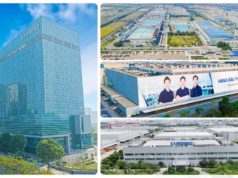Virtually everywhere you look, Bay Area tech businesses are running into walls. Smartphones were revolutionary and lucrative, but the U.S. market is saturated, and Apple’s iPhone sales have fallen for three quarters. The “app economy” has matured, with more people using existing apps than downloading new ones. And Facebook, which has filled users’ news feeds with so many ads it can barely add more, is predicting its revenue growth will slump next year.
Silicon Valley needs its next big thing, a focus for the concentrated brain power and innovation infrastructure that have made this region the world leader in transformative technology. Just as the valley’s mobile era is peaking, the next frontier of growth and innovation has arrived: It’s Siri in an Apple iPhone, Alexa in an Amazon Echo, the software brain in Google’s self-driving cars, Amazon’s product recommendations and, someday, maybe the robot surgeon that saves your life.
It’s artificial intelligence, software that can “learn” and “think,” the latest revolution in tech.
“It’s going to be embedded in everything,” said startup guru Steve Blank, an adjunct professor at Stanford. “We’ve been talking about artificial intelligence for 30 years, maybe longer, in Silicon Valley. It’s only in the last five years, or maybe even the last two years, that this stuff has become useful.”
Achievements that were “unthinkable only a few years ago” are being made possible by artificial intelligence, Google CEO Sundar Pichai wrote in a blog post. “The last 10 years have been about building a world that is mobile-first, turning our phones into remote controls for our lives,” Pichai said. “But in the next 10 years, we will shift to a world that is AI-first.”
Experts say AI will play an increasingly large role in our lives, transforming how we work, how we live — and even, perhaps, whether we work or whether we live. Inclusion of AI into virtually every area of computing — and life — will bring both progress and upheaval to the Bay Area tech industry, Blank said.
“The valley has gone through waves of innovation,” Blank said. “We were the semiconductor valley, then we were the PC valley, then we were the web 1.0 valley. Each of those waves was built on a new set of technology and created a whole new set of companies.”
Already, entire new industries are arising from AI technology, while robot-aided manufacturing surges, opening up opportunities in nearly every area of business, said Oren Etzioni, CEO of the Allen Institute for Artificial Intelligence.
“It’s going to be completely transformative, but at the same time it’s going to take time,” he said.
Major industry players are betting big on “bots,” interactive virtual assistants that learn from user inputs. Among the ever-expanding bot army we find Siri and Alexa, Google’s Assistant and the many “chatbots” created by companies to facilitate customer transactions, such as Taco Bell’s “TacoBot” which understands spoken language to take customer orders via smartphones.
“People are suckers for a more efficient way to do things,” Etzioni said. “We will see rapid advances in the usefulness of bots.”
As consumers see AI creep into their devices, the technology is also beginning to play an increasingly expansive role in business. Amazon and Google both offer AI-powered services that can be applied to the data that firms store on those companies’ storage clouds. On Wednesday, the Washington Post announced it will use Amazon’s AI-based “Polly” text-to-speech software — which can produce 47 different voices and convert 24 languages — to create audio versions of articles. And in September, San Francisco’s Salesforce unveiled “Einstein,” artificially intelligent software that can ingest all of a client company’s data and offer solutions for a given problem, such as predicting which sales leads are likely to pan out.
Pursuit of AI technology has fueled acquisitions, with established firms globally buying almost 140 AI-focused companies since 2011 — with 40 deals last year alone — according to market research firm CB Insights. Intel has rapidly built up its AI offerings through the purchase of Saffron, Movidius and Nervana, which Intel CEO Brian Krzanich referred to in a blog post as “leading-edge accelerants required for the growth and widespread adoption of AI.”
Although AI has been around since the 1950s, its trajectory started angling upward with the advent of “big data,” the enormous information sets made possible by storage technology, large-scale data collection and advances in computing power.
This year AI got a poster boy, of sorts. Google’s AlphaGo AI software ingested 30 million moves from world-class games of Go, the ancient Chinese strategy board game, and laid waste to 18-time world champion Lee Sedol in three straight games.
Teaching software to play games advances technology that can be applied to more serious endeavors. On Tuesday, another Google division, Verily, published results of its successful use of an AI image-analysis algorithm to identify a diabetes-related eye disorder.
Verily in 2015 announced a partnership with Johnson & Johnson to develop AI-guided surgical robots, an enterprise spun off into Mountain View-based Verb Surgical. The startup has 200 engineers, some from Verily, working on the software and devices, training the AI by having it “watch” videos from hundreds of surgeries.
AI’s burgeoning ability to make and learn from decisions is accelerating its impact, said UC Berkeley computer sciences professor Sergey Levine.
It is decision-making that sets sophisticated AI programs apart from pattern-recognition AI software, which gets trained to perform tasks on a specific data set, as with photo-identification processes, but then remains “static” without learning on its own, he said.
“That’s the part that’s going to change,” Levine said. “It’s going to be something that continuously interacts with the environment it’s deployed in, and continuously improves itself through its own experience.”
AI-based products such as household-chores robots or self-driving cars can be networked together, so that what each device learns can be applied across all the devices through “collective learning,” Levine said. He foresees “systems that interact with humans using natural language.”
As AI improves and spreads, it will increasingly replace human labor, taking on tasks and jobs previously done by people, experts say. “I’m very worried about jobs,” Etzioni said. “Of all the concerns that float around about AI, AI and jobs is the one to focus on.”
Lisa Spelman, vice president of Intel’s data center group, takes a more optimistic view, noting that AI-powered image recognition, for example, has created many jobs for software engineers.
“I see this as similar to many other innovation cycles and technological transformations where there has been that concern,” she said. “In the end, it has turned into more opportunities, just different ones.”
© 2016 San Jose Mercury News under contract with NewsEdge. -.






